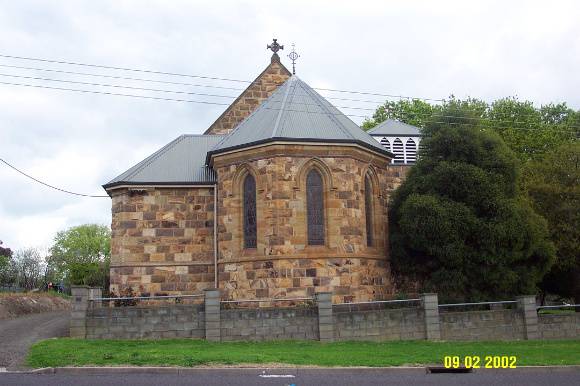| Back to search results » | Back to search page » |
|
HOLY TRINITY ANGLICAN CHURCH COMPLEX
Locationcnr Henty and Church Streets COLERAINE, Southern Grampians Shire
File Number0362LevelStage 2 study complete |
|
Statement of Significance
What is significant? The interior of Holy Trinity Anglican Church contains many features typical of 19th century ecclesiastical architecture, including several finely crafted stained glass windows, lectern, altar crucifix and pulpit. Many of the furnishings were donated by prominent members of the Coleraine region. There are several traditional wall memorials to local identities. There is an important pipe organ in the church, made by Meadway and Slatterie, and installed in 1921. The timber vicarage, built in 1901, was designed by the leading Melbourne domestic architects, Ussher and Kemp who were important for the development of the Queen Anne/Federation style. The contractor was E J Bonham. The building is much altered internally but the attic rooms retain their joinery and detailing. The building is in good condition. There is one substantial tree in the grounds, a large Quercus robur. There is a memorial flag pole to Sergeant Arthur William Tippett, which is surrounded by a formal planting of four Cupressus sempervirens. How is it significant? Why is it significant? Holy Trinity Anglican Church is of historical significance as the earliest substantial church to be built in the district, and the oldest to survive to the present day. The early history of the church is closely connected with the ministry of the highly influential Rev. Dr Francis Thomas Cusack Russell. The donation of land, materials and furnishings represents the affluence and generosity of the many important early settlers who belonged to the congregation, including the Winter and Cooke families, the McConochies, McKeberys and Trangmars. The grounds are historically significant for the commemorative Quercus robur and the The complex as a whole is historically significant as the expression of the role and position of the Anglican Church and its congregation in the community for over one hundred and fifty years.
The Holy Trinity Anglican Church Complex comprises the church with its contents and extensions, the vicarage and the grounds. The church is a well-crafted stone building in the Early English Gothic revival style, typical of ecclesiastical architecture of the period. It was built in 1864 to the design of the Hamilton architect, James H Fox by the builder, Mr Blackstone. The form of the church is also typical with a nave of four bays, one aisle and a vestry on the sorth side and a polygonal apse as the chancel. The base of the tower, not completed but with a timber belfry is on the northern side. The walls are constructed of a local stone, the roof is slate and the windows are either clear or coloured and stained glass donated as memorials. The building retains a high degree of integrity and is in good condition although with signs of settlement.
The Holy Trinity Anglican Church complex is of architectural and historical significance to the State of Victoria, the community of Coleraine and the Southern Grampians Shire.
Holy Trinity Anglican Church is of architectural significance as an example of the work of the important local architect, James H Fox, and for its possible connection to William Wilkinson Wardell, the significant Melbourne architect. It demonstrates architectural significance for its use of the Gothic revival style to express religious values, for the range and quality of its interiors, including the altar, lecturn, several memorials and the organ, and as a comparison with the churches of other denominations in Coleraine. The vicarage is of architectural significance as the work of the leading Melbourne domestic architects, Ussher and Kemp and as an early example of the Queen Anne/Federation style.
Group
Religion
Category
Church






